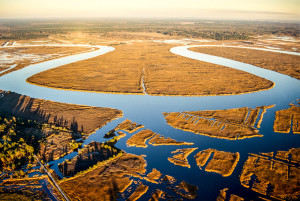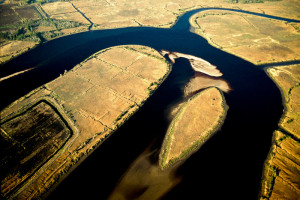Rice cultivation created enormous wealth in antebellum South Carolina, as well as being a major factor in the creation of slavery in America. What is perhaps often overlooked, however, is the incredible skill and expertise it took to construct the intricate hydraulic systems of dikes and canals necessary for rice cultivation. These devices connected plantation rice fields to one another and within the vast amount of land that was cultivated by hundreds of thousands of enslaved Africans.

Remnants of the Rice Culture, an exhibition featuring the work of Charleston-based photographer David Shriver Soliday at the Franklin G. Burroughs-Simeon B. Chapin Art Museum, provides a modern-day visualization of how the various tasks on the ground, or in the fields, coalesced into the entire, complex rice plantation system – through Soliday’s aerial photography of retired but still extant tideland rice fields in the South Carolina Lowcountry.
The exhibition accompanies Rice: Paintings by Jonathan Green and Indigo: Works in Denim by Jim Arendt, two exhibits also on display at the Art Museum, which explore the economic and cultural impacts of South Carolina laborers, both enslaved and free, who worked these two lucrative crops. All three exhibits run from Sept. 29, 2015 through Jan. 7, 2016 with gallery hours from 10 a.m. – 4 p.m. Tuesday through Saturday and 1 – 4 p.m.Sundays. Soliday will be at the Art Museum for a gallery talk on Sunday, October 25 from 2-3:30. The talk is free-of-charge and open to the public.
Soliday’s beautiful, sharp and graphic-looking images are printed on infused aluminum sheet metal, a sleek and contemporary look that juxtaposes wonderfully with the sweeping views of South Carolina’s colonial past. The 21 photographs in the exhibition, aside from the awe and beauty of their composition and perspective, provide a uniquely accessible way of looking at tideland rice culture while prompting varied dialogues about the physical landscape, human capability and intervention and the rice industry’s enduring environmental and social impact.
David Shriver Soliday is a freelance photographer whose images have been pictured in such major publications as National Geographic, National Wildlife and Smithsonian. Soliday spent most of his youth in the Litchfield Hills of Connecticut, where early on he developed an interest in birds and photography. His interest in photography became more serious while he was working as an expedition mechanic for Land Rover in Nepal, Africa and Iceland.Developing an interest in world cultures, he earned a degree in cultural anthropology from Amherst College in Amherst, Massachusetts, in 1976.
The following year, he moved to the Lowcountry and lived beside the rice lands for the next 25 years. Since 2007, he has actively studied the South Carolina rice culture while photographing the rice landscape. Soliday’s aerial perspective distinguishes the subtle fading imprints of rice production and frames the monumental scale of the precisely constructed fields, dikes and canals in ways otherwise difficult to comprehend.
The Art Museum is located at 3100 S. Ocean Boulevard in Myrtle Beach, across from Springmaid Pier. Admission is free, but donations are welcomed. For more information, call843-238-2510 or visit MyrtleBeachArtMuseum.org.

